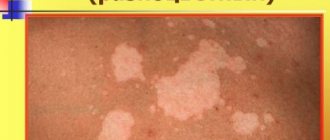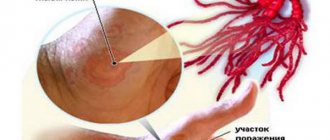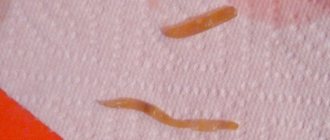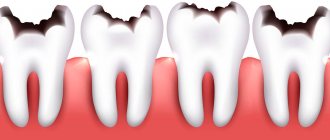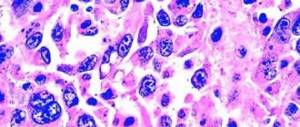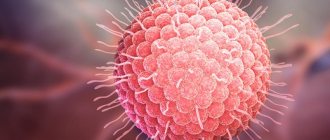Useful tips
Author Oksana Knopa
Date
May 12, 2016
2,482
Share
In 1860, the famous French dermatologist first described the external symptoms of a disease of unknown etiology, today called Gibert's pityriasis rosea (in accordance with the name of the discoverer). Today, little has been added to the ancient information; the causative agents of the disease have not been found, although some luminaries of medicine believe that the body is affected by viruses of type 7 (rarely 6), and another opinion of professors is that the disease has an infectious allergic origin. Regarding how to treat Zhiber's pink lichen, doctors offer 3 methods.
Ringworm is very unpleasant and needs to be treated
- Risk group
- How does pityriasis rosea manifest in people, symptoms (signs)
- Treat pink lichen in humans or forget how not to harm: ointments, preparations, medicines
- Effective treatments
- For minor symptoms
- In acute current form
- For complications of the disease
- If a child gets sick: folk remedies and vitamins
The first is not to treat at all, since irritating ointments and tablets can lead to complications, but to follow a diet and take vitamins.
WATCH VIDEO INSTRUCTIONS
The second is to be sure to treat with local talkers and antibacterial agents. The third is to completely eliminate foods that cause allergies from your diet, take antihistamines and antibiotics.
If a characteristic rash appears, be sure to consult a doctor to rule out other diseases and for advice on treatment. In the meantime, let’s take a closer look at what is allowed and what is not allowed to be used for Zhiber rosea.
What is pityriasis rosea
The disease pityriasis rosea (Zhiber's pityriasis) refers to skin infections accompanied by itching and allergic rashes throughout the body (see photo below). The disease is viral in nature, but its causative agent has not been precisely identified. The disease occurs due to weakened immunity, after an infectious disease, against a background of stress, and with metabolic disorders. In rare cases, skin lesions disappear on their own, but it is better not to let the situation get worse, but to consult a dermatologist in a timely manner.
How to cure pityriasis rosea
Roseola scaly or pityriasis rosea is a viral disease that causes pink or reddish skin rashes. First, several plaques with a diameter of 2-4 cm appear, then the rash spreads throughout the body. The process is accompanied by skin itching; in difficult cases, general intoxication of the body, weakness, and enlarged lymph nodes occur. Treatment of pityriasis rosea in humans is aimed at strengthening the immune system with the help of multivitamin complexes and relieving allergic skin reactions with antihistamines.
In adults
A skin infection called pityriasis rosea is recommended to be treated at home, comprehensively, with medications in the form of tablets or antihistamine ointments. If treatment is started in a timely manner, dermatologists prescribe an antiviral drug. A set of measures to strengthen the immune system is necessarily recommended, and hygiene standards are also explained to avoid relapse of the disease. The basic rules supporting drug therapy include the following recommendations:
- Following a special diet, avoiding citrus fruits, foods high in sugar and other strong allergens.
- Wash in the shower using special mild hypoallergenic detergents.
- Protect affected skin areas from direct sunlight.
- Refusal to wear synthetic underwear and clothing.
- Refusal of excessive physical activity, avoiding overheating of the body - excessive sweating aggravates the course of the disease and leads to an accelerated spread of the rash.
In children
This pathology also occurs in children, mainly between the ages of four and ten years. Treatment of pityriasis rosea in children is aimed at supporting the immune system and relieving skin itching with antihistamines. When selecting a drug and developing a treatment regimen, the doctor must take into account the age and weight of the baby. In order not to provoke an increase in rashes, doctors, as a rule, do not prescribe special ointments for children under 12 years of age, but they will recommend skin-soothing compresses and other traditional medicine.
Clinical picture
Before the onset of pityriasis, a person may feel unwell, he may experience pain in the joints, cephalalgia, inflammatory reactions in the lymph nodes, after which a maternal plaque appears - one large bright spot on the skin.
After this, the next stage begins - the spread of bright pink or yellowish spots throughout the body, slightly rising above the surface of the epithelium. A rash like this does not appear overnight. The spots gradually spread throughout the body, sometimes this occurs in outbreaks or extinction of the pathological process. These formations are symmetrical, have clear boundaries, and their shape is elongated or round. It is important to recognize the symptoms of Zhiber's pityriasis rosea (photo in the article) in a timely manner.
The rash, representing pityriasis rosea, spreads throughout the body. The initial elements are located on the chest, after which they move to the back, inguinal folds, neck, hips, and shoulders. A little less often, lichen affects the limbs and genitals. Plaques located on the scalp and face are extremely rare.
Pityriasis never spreads to the mucous membranes. Painful sensations, as a rule, do not bother a person; only occasionally, in the initial phase of the disease, patients notice slight itching.
During approximately the first seven days of the pathological process, in the middle of each of the spots, the epithelium begins to dry out and peel off into many tiny scales. During this period, you should not wear tight clothes made of synthetic fabrics and you should avoid excessive sweating. Do not lubricate rashes with alcohol solutions and ointments containing zinc or sulfur in order to avoid skin irritation.
After such scales disappear, a pink rim remains in place of the plaques, which rises around the spot, and after its complete disappearance, pigment spots may appear, which also disappear over time.
Ointment for pityriasis rosea
A number of experts are of the opinion that you should not apply special creams to pityriasis rosea immediately when a rash appears, but rather you should direct all efforts to restoring the immune system and maintaining hygiene standards. With this approach, it is possible to eliminate spots on the skin without the use of antihistamines. If the number of skin lesions rapidly increases, the doctor will prescribe an ointment that relieves itching, reduces peeling and inflammation of the skin.
- How to attract a man
- Grooves on the tongue
- How to call a phone via the Internet for free from a mobile phone and computer
Salicylic
It is recommended to treat types of lichen using salicylic ointment in case of extensive skin lesions accompanied by itching and other unpleasant sensations. Its main component, salicylic acid, has the following medicinal effects:
- relieves inflammation;
- disinfects the skin, prevents the spread of foci of infection;
- soothes damaged skin;
- reduces the formation of sweat in the subcutaneous glands.
The method of using the product is as follows: in the morning, the affected areas of the epidermis are smeared with iodine (brilliant can be used), at night the spots are lubricated with salicylic ointment, a thin layer of 0.5-1 cm. The duration of treatment is from 7 to 10 days. Contraindications to the use of the drug are renal failure and individual intolerance to salicylic acid.
Sulfuric
A strong antiseptic, sulfur ointment is used in the complex treatment of infectious or parasitic skin lesions, including advanced cases of pityriasis rosea. Only a specialist can recommend treating roseola with this remedy, since in some cases its use can provoke an accelerated spread of skin rashes. In general, the drug is well tolerated, has a softening, drying, and bactericidal effect. The ointment is applied to affected areas of the skin twice a day for two weeks.
Zinc
A universal drug for combating skin diseases of an infectious and allergic nature, zinc ointment is used as a remedy to relieve irritation from sore skin. Pregnant women can treat pityriasis rosea with its help, since the active components of the composition are practically not absorbed into the skin and will not affect the development of the fetus. Apply the ointment according to the spot application scheme on previously cleaned damaged areas of the skin two to three times a day for 10-15 days. The drug is not prescribed if you have an individual intolerance to its components.
Clotrimazole
You can get rid of pityriasis rosea with the help of the drug Clotrimazole. This antifungal agent, unlike the ointments described above, helps not only relieve the symptoms of the disease, but also cure the infection that caused it. The ointment is applied to previously washed and dried affected skin two to three times a day, the course duration is 2-3 weeks. Contraindications are the first trimester of pregnancy, lactation and childhood (up to 12 years). During use, avoid contact of the product with mucous membranes.
Akriderm
The main component of Akriderm ointment, betamethasone, belongs to the group of corticosteroids. These substances prevent the excessive accumulation of leukocytes in areas of skin lesions, thereby reducing inflammation and preventing swelling. Treating pityriasis rosea with this remedy is contraindicated for a number of viral skin diseases (herpes, skin tuberculosis), as well as during breastfeeding. The duration of therapy can be from 7 to 15 days, the application regimen is selected individually, depending on the patient’s skin condition.
- How to withdraw money from Yandex wallet
- Obsessive-compulsive disorder - symptoms and treatment. Diagnosis of obsessive-compulsive disorder neurosis and test
- Products containing iron
Pityriasis rosea tablets
Prescribing oral medications may be more effective in some cases of disease development than treating pityriasis rosea with topical medications. As part of complex therapy at home, the doctor will prescribe an antiviral or antibacterial drug that will help the body cope with pathogenic bacteria and get rid of the causative agent.
Acyclovir
A cure for pityriasis rosea and other viral skin infections, Acyclovir helps treat the disease at an early stage of development, with a low degree of skin damage. The drug is active against viruses that cause lichen of all types. It requires caution when treating patients with renal failure; it is not prescribed during pregnancy or for children under 3 years of age. The dosage regimen depends on the patient’s age and other individual characteristics. The instructions for use recommend a dose of 800 mg 4 times a day for 5 days.
Erythromycin
This highly digestible antibiotic can be prescribed in the first days of the development of skin infectious diseases. Treatment of pityriasis rosea with the use of Erythromycin is possible only if prescribed by a doctor and there are appropriate indications. It is contraindicated during pregnancy and in patients with renal and liver failure. The dosage regimen is selected individually in accordance with the patient’s condition, the maximum daily dose is 1 tablet three times a day. The duration of therapy cannot be more than 7 days.
Zovirax
A more expensive analogue of Acyclovir, with a completely identical composition of the active substance - Zovirax. It can be used as a replacement in case of individual intolerance to the auxiliary components of Acyclovir. The dosage and regimen of taking the drug is selected individually; it is recommended to begin treatment of pityriasis rosea with its help no later than five days from the moment the first skin plaque appears, and only as prescribed by the attending physician.
Drug treatment and prevention
When treating pink lichen of Zhiber, symptomatic therapy is usually used. These include:
- Antihistamines: Erius, Suprastin, Cetrin, Tavegil, etc.
- Medicines that reduce inflammatory reactions in the body: calcium chloride, Pantothenate.
- Local medications in the form of ointments containing hormonal substances: Elokom, Advantan, Momat, Lokoid, etc.
- Solutions and pastes containing zinc, naphthenic hydrocarbons 2%, borate 2%, for example, “Tsindol”, zinc ointment, etc.
In the treatment of Zhiber's pink lichen, you should not use solutions such as iodine, Fukortsin, Tsindol, brilliant green, boric acid, potassium permanganate, hydrogen peroxide, apple cider vinegar, sea buckthorn oil and other irritants.
The use of physiotherapeutic procedures, for example, mid-wave UV irradiation, is also recommended.
Folk remedies for pityriasis rosea in humans
The question of how to treat pityriasis rosea other than medications usually arises when drug therapy is not recommended by a dermatologist. For example, when a small child or a pregnant woman suffers from the disease. Roseola exfoliates can be cured at home with the help of natural remedies, subject to a diet and lifestyle aimed at strengthening the immune system, and following hygiene rules.
It is recommended to take an alcohol tincture of celandine both externally and internally. Fresh leaves and inflorescences are poured with vodka or alcohol (400 mg of crushed herbs per 0.5 liter of vodka) and infused in a glass container for two weeks. The resulting tincture is diluted with water in a ratio of 1:5. It is used both locally and orally, until the last skin plaque disappears, according to the following schemes:
- orally: 12-15 drops of solution with water, before meals, three times a day;
- Locally: twice a day, lubricate the affected areas with a cotton swab soaked in the tincture.
This recipe has proven itself to be excellent: treatment of pityriasis rosea is carried out using a “talker” based on birch tar and salicylic ointment. To obtain the product, the ingredients are mixed in equal parts until a homogeneous mass is obtained. The prepared mixture is applied to the affected areas of the skin twice a day until the skin manifestations of pityriasis rosea completely disappear.
The disease can be treated with apple cider vinegar (topically, in its pure form), elderberry tincture (similar to the treatment regimen for celandine tincture), buckwheat decoction (topically), cabbage leaves soaked in sour cream and applied to areas of skin inflammation. Pityriasis rosea responds well to treatment with folk remedies; the effect of their use becomes noticeable after 5-7 days from the start of the course of treatment.
Treatment of the disease
Patients who suffer from uncomplicated pityriasis, according to medical experts, do not need treatment for this disease, since within two months from the onset of the pathological condition, healing occurs spontaneously.
When pityriasis rosea goes away, as a rule, no traces remain on the skin, and a person never has a similar problem again. Zhiber's lichen is not contagious, and if the patient feels well and does not exhibit symptoms of malaise characteristic of the onset of the disease, he is allowed to visit public places and perform professional duties.
What is the treatment for Zhiber's pink lichen (the photo shows its appearance)?
When lichen is accompanied by severe itching, pain or other pathological phenomena, certain therapeutic procedures are necessary. For such purposes, some antihistamines are used in the form of tablets, solutions for oral use, as well as immunomodulators to eliminate the inflammatory process and itching.
It should also be noted that bathing in water, friction of the skin and pressure on it, as well as ultraviolet irradiation and some medications that contain tar and sulfur, lead to the fact that Zhiber’s lichen begins to spread throughout the body even more, in as a result, recovery occurs much later than expected. Therefore, patients with this pathology are not recommended to visit a bathhouse, sauna or swimming pool. You can wash in the shower with warm water and under no circumstances use a washcloth.
In addition, you should avoid activities that can lead to excessive sweating, as this also leads to the progression of this skin disease. During the course of the pathology, doctors also strongly recommend avoiding tanning and sunbathing.
In addition to the above, the list of recommendations includes normalizing the patient’s diet, eliminating fatty foods, coffee, alcoholic drinks, and also moderating the amount of sugar and salt consumed.

